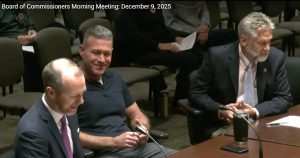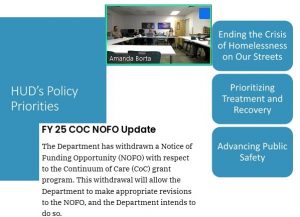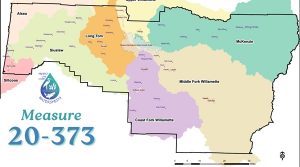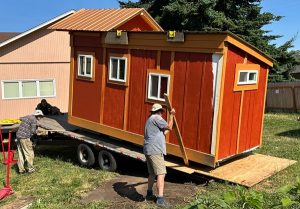After ice storm, city considers extended shelter hours, disaster drills
8 min read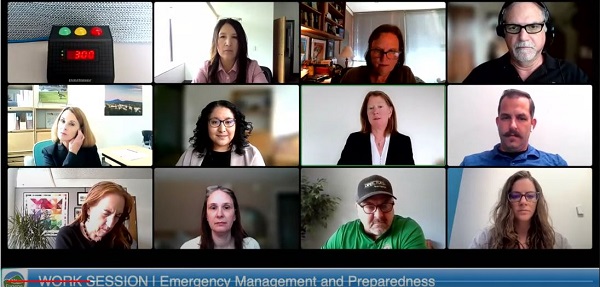
Facing natural disasters that are more frequent, more severe, and year-round, the Eugene City Council asks for emergency management exercises. At the June 26 work session:
Councilor Lyndsie Leech: When I was an intern at the Belize embassy, the U.S. Embassy, we did some simulations of emergency situations, of natural disasters. I feel like it would be extremely beneficial to our city to be able to run a simulation so that we can work on some of these things that we’re talking about: What are our roles and how do we operate and how do we communicate? And is that a possibility for us to plan or schedule?
[00:00:45] Sarah Medary (Eugene, city manager): For my annual performance evaluation, one of my stakeholders was Frank Lawson, general manager of EWEB, and we actually had a conversation about the possibility—we have not, like, it was just he and I, so this is news to everybody else—the possibility of doing a sort of tabletop simulation exercise with both of our elected bodies together, either as observers or participants, so it’s very fresh. But just so you know, I’m also thinking about that. So more to come on that.
[00:01:17] Jennifer Lleras Van Der Haeghen (Eugene Employee Resource Center): My name is Jenny Lleras Van Der Haeghen. I’m the acting director of the Employee Resource Center. Our emergency management team has recently gone through a leadership transition, which is why I’m presenting to you today. The purpose of this presentation is to share an overview of the emergency management program and share roles and responsibilities of elected officials during emergencies.
[00:01:36] John Q: Eugene’s former emergency manager now serves in that role in Corvallis, and Lincoln County’s former emergency manager, hired as a temporary employee to work on planning, is covering day-to-day operations until the new official is hired.
[00:01:50] The session looked ahead to new exercises, and also looked back at lessons learned from the ice storm. Although the ice storm was predicted to hit during a three-day weekend, the city made no plans to open its facilities on the holiday. Local warming shelters were overwhelmed.
[00:02:08] Jennifer Lleras Van Der Haeghen (Eugene Employee Resource Center): After any emergency, the organization always conducts debriefs to identify gaps, successes, and proactive work that needs to be done to improve response in the next event. Coming out of the ice event, as with any debrief process, there were gaps identified.
[00:02:22] City leadership plans to have a policy discussion this summer to examine whether or not the organization should revisit the core purpose of our facilities for emergency events and, for example, whether or not we might open them to provide day sheltering.
[00:02:35] The organization has always operated facilities under standard hours of operations when staffing is allowed. Standard operations have allowed community members to access community centers, libraries, and other city facilities that are open to the public to cool down, access clean air, and even find a warm place to shelter during typical business hours.
[00:02:55] Another gap is that the city does not have a team readily available to respond to day or night sheltering needs for residents during a winter weather event. The city has not historically responded to emergencies by providing this type of response. In fact, many employees who typically support community members accessing shelter, housing needs in a day-to-day capacity are the same people who are called to work to perform emergency response efforts to support critical infrastructure.
[00:03:22] So recognizing those gaps, we’re engaged in thinking about what we might do in the future. The city staff also engaged in three debrief meetings with Egan (Warming Shelters) to better understand challenges and the work that the organization faced in responding to the storm.
[00:03:39] Councilor Emily Semple: I’m really happy to hear that we might expand the use of city buildings for especially Egan (Warming Centers), but also heat and smoke. We have a lot of resources that we don’t use, and I think a big part is staffing.
[00:03:56] So, anything we could do to encourage, help, increase the staff for Egan would be great. I’d love to see us take rain into consideration, because 34 (degrees) and rain is worse than 28 (degrees) and snow, because it’s drier.
[00:04:16] I’m grateful to CERT (Community Emergency Response Teams), and I really hope, well, we could expand that. It’s a really good way for neighbors to get to know each other, the preparedness plan for the neighborhoods, they don’t know how many groups are doing that.
[00:04:29] But I found neighbors often don’t know neighbors in the city, and that’s something that in an emergency, we’re going to get to know each other fast. So, wouldn’t it be great to know that. So, yeah, thank you for thinking about the winter sooner than later.
[00:04:46] John Q: After the presentation, Councilor Mike Clark.
[00:04:49] Councilor Mike Clark: Obviously, in your presentation, you were talking about a whole community approach of everybody being involved in all jurisdictions in any kind of discussions and planning. To what degree are the school districts involved?
[00:05:06] Jennifer Lleras Van Der Haeghen (Eugene Employee Resource Center): The coordination between the schools’ emergency management teams and ours are really important as we think about that whole community approach. And also, as we think about different sites that people may turn to in an emergency to access different types of resource or information.
[00:05:23] John Q: The city may hire a training coordinator.
[00:05:27] Mike Caven (Eugene Springfield Fire, chief): The county’s just reset their team. Obviously, there’s going to be some changes in the future in our team. One of the core components of your office of emergency management in the FEMA structure, right, is your training and exercise coordinator, the person who’s responsible for planning, documenting, and supporting that.
And so I would anticipate as we refill that cup as the county refills theirs, which we just got to meet them during a multi-agency wildfire tabletop last week, which included EWEB and many other partners, that staff is building its way back as we’ve had a number of changes to county and city.
[00:06:02] John Q: The exercise would let local agencies practice responding together during a disaster.
[00:06:09] Councilor Randy Groves: I want to specifically get into accessing additional resources as we start seeing that we’re going to go through everything that we have here locally and even through our mutual aid.
[00:06:22] So for the greater disaster declaration, that’s still through the city manager, but it still goes city manager—does it bypass the county then and go to the state?
[00:06:32] Mike Caven (Eugene Springfield Fire, chief): I believe we still have to route or involve the county in our declaration.
[00:06:37] Councilor Randy Groves: I know we need to involve them in the declaration, but it’s more working together as opposed to directing the request to the county, to the state, to the feds. Okay, and there’s not a role for elected officials in that. Is that correct?
[00:06:52] Mike Caven (Eugene Springfield Fire, chief): Not that I’m aware of. The city manager might correct me on that one, but I believe it’s delegated to her.
[00:06:59] Councilor Randy Groves: It makes more sense that the staff would handle it, but I just wanted to confirm. That’s always been a little bit fuzzy. And I think those pathways, it’s really important that those are crystal clear because you don’t have time to dance around, when your world’s falling apart.
[00:07:13] John Q: Asking about the role of public officials during an emergency:
[00:07:18] Councilor Lyndsie Leech: One of the roles that was indicated was that we would be available to speak to our constituents and to respond. But our ability to communicate with the entirety of our wards, for example, is very limited. Do we have a communication platform that we will be able to use in an emergency situation to communicate with constituents?
[00:07:41] Jennifer Lleras Van Der Haeghen (Eugene Employee Resource Center): I really appreciate the question, Councilor Leech. We can do some work to think about what options and access points we have for communication for city councilors specifically. One of the things that I’ll say, though, is that we have a really strong relationship with the county’s emergency manager. Certainly if we needed to send an alert out, though it’s their program, they would support us in sending that type of alert to our community specifically. What I’m not as familiar with is how specific the zones can be and if we could specify a zone as a ward for those types of communications. So those are some of the things I need to follow up on.
[00:08:18] Mike Caven (Eugene Springfield Fire, chief): Our own 911 center has the capability to send out community emergency notifications, which they use Everbridge, just the same thing the county uses. But again, as that scales up, we can get a notification out quickly through Central Lane if they can’t coordinate with the county ahead of time. 99% of the time, they’re coordinating with the county when we request those notifications to go out. And the county’s actually the one who delivers the message to the subscribers and in kind of that worst case scenario, if we had to do like the Amber Alert, take over your phone, that technology exists as well.
[00:08:56] But again, you’re very limited to what you can tell them. Usually it’s ‘Ready, set, go’ in the evacuation levels or ‘Go now and go east,’ ‘Go west.’ It’s not really built out to be a specific direction.
[00:09:11] That’s where app-based programs, in the evolving emergency management communications space, which continues to expand year over year, becomes more relevant. But you do have to get community members to subscribe, download and have the app that gives them more true information up to and including routing you to your evacuation zone, your sheltering site, you name it.
[00:09:36] John Q: The city also promoted alerts, and the state’s newest preparedness program.
[00:09:42] Jennifer Lleras Van Der Haeghen: The Be 2 Weeks Ready campaign calls on individuals, families, and communities to stay aware of potential risks, have an emergency plan, and enough food and water to survive for at least two weeks. Community members can access toolkits related to this campaign to Be 2 Weeks Ready online, and these toolkits provide step by step units to make this preparedness activity more accessible.
[00:10:07] And one way that every community member can increase their own preparedness is by signing up for Lane Alerts. This is a system that enables Lane County residents to receive critical information quickly in a variety of situations, such as severe weather, wildfire evacuation, and other emergency situations.
[00:10:24] John Q: The Eugene City Council asks for simulations to let public officials practice disaster response. As Councilor Randy Groves says: ‘You don’t have time to dance around when your world’s falling apart.’
